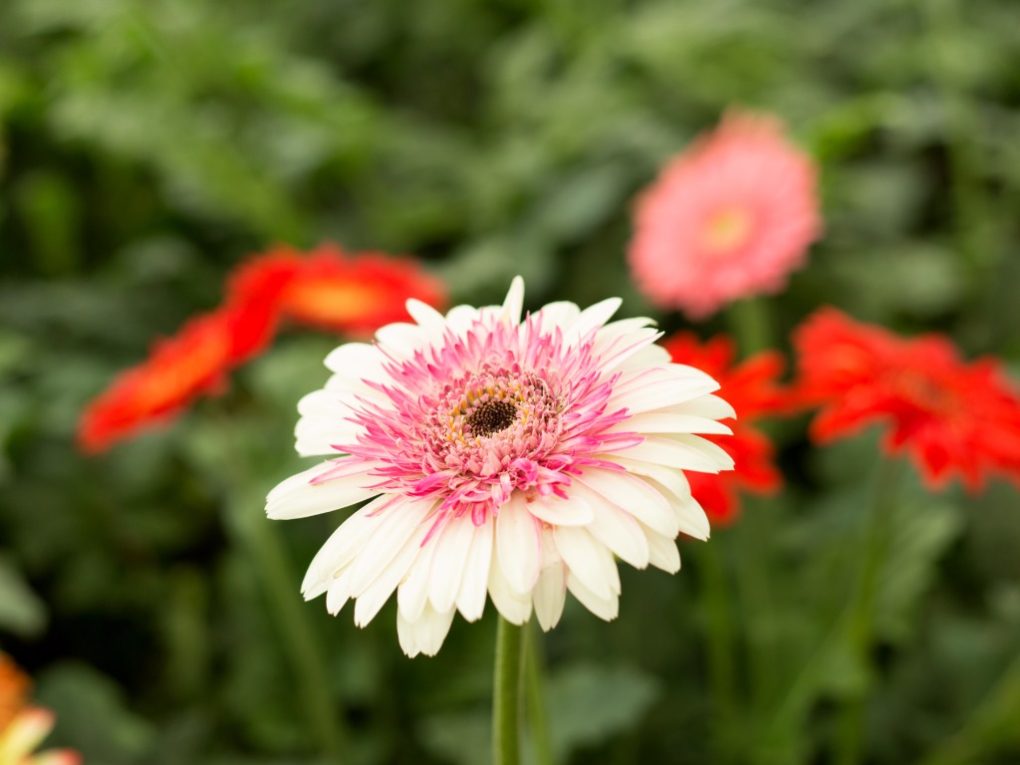Are Gerbera Hardy? A Guide to Understanding Gerbera’s Hardiness
Gerbera flowers (Gerbera jamesonii) are not considered hardy plants in the typical sense, as they are sensitive to cold temperatures and can be easily damaged by frost.
These perennial plants thrive best in USDA hardiness zones 8 to 11, where minimum winter temperatures stay above 10°F (-12°C). Gerbera daisies can be grown as annuals or in containers that can be moved indoors during the winter to avoid freezing temperatures in colder climates. They require well-drained soil, moderate watering, and plenty of sunlight for optimal growth.

Table of Contents
Climate and Geographical Preferences of Gerbera
Gerbera daisies, or Gerbera jamesonii, are popular ornamental flowers in various vibrant colors. While many gardeners belove them, it is important to understand Gerbera’s climate and geographical preferences to ensure their successful growth and longevity.
Climate Requirements
Gerbera daisies thrive in moderate to warm climates with mild temperatures, preferring a temperature range between 65°F (18°C) and 75°F (24°C) during the day and around 55°F (13°C) at night. These flowers are not frost-tolerant and should be protected from temperatures below 50°F (10°C) to prevent damage or death.
Sunlight Exposure
Gerbera daisies are sun-loving plants that require ample sunlight to flourish. They prefer full sun to partial shade, with at least 6 hours of direct sunlight daily. In regions with intense heat or strong afternoon sun, it is advisable to provide some afternoon shade to prevent scorching of the delicate petals.
Soil Requirements
Well-draining soil is essential for the successful cultivation of Gerbera daisies. They prefer loamy soil with good organic matter content. The soil should have a pH level between 6 and 7, slightly acidic to neutral. Therefore, it is recommended to amend heavy clay soils with organic matter or create raised beds to ensure proper drainage.
Watering Needs
Gerbera daisies have moderate water requirements and are susceptible to root rot if overwatered. It is best to water the plants deeply but infrequently, allowing the top inch of soil to dry out between waterings. To prevent fungal disease, avoid wetting the foliage. When the weather is hot and dry, it may be necessary to increase watering frequency to keep the plants hydrated.

Geographical Considerations
Gerbera daisies are native to South Africa and thrive in temperate coastal regions. However, they can be successfully grown in various locations with the right care and conditions. Gerbera daisies are often cultivated as annuals or grown indoors in colder climates as potted plants. Gardeners in these regions may also use protective measures such as mulching or bringing the plants indoors during winter.
Temperature Tolerance of Gerbera
Gerbera daisies, known for their vibrant blooms and wide range of colors, are a popular choice among gardeners. However, it’s essential to understand their temperature tolerance to ensure their successful growth and longevity.
Cold Hardiness
Gerbera daisies are native to warmer regions and thrive in moderate temperatures. They are generally considered tender perennials, meaning they can survive mild winters with proper care. However, they are easier than other plants and may not withstand severe frost or freezing temperatures.
Ideal Temperature Range
For optimal growth and blooming, Gerbera daisies prefer a temperature range between 65°F and 75°F (18°C to 24°C) during the day. They can tolerate slightly higher temperatures but may exhibit signs of stress or reduced flowering if exposed to prolonged heatwaves.
Temperature Extremes
Gerbera daisies have their limits when it comes to temperature extremes. For extended periods of time, they can be damaged by temperatures below 50°F (10°C) or above 85°F (29°C). Cold temperatures can cause frost damage to their leaves and flowers, while excessive heat can lead to wilting, browning of foliage, and reduced blooming.
Protecting Gerbera Daisies from Cold
If you live in an area with colder winters, providing adequate protection for your Gerbera daisies is essential. Consider the following measures:
- Mulching: Before the first frost, apply a layer of organic mulch around the base of the plants. This helps insulate the roots and protect them from freezing temperatures.
- Covering: Use frost blankets, cloths, or protective covers to shield the plants during frosty nights. Secure the covers tightly to prevent cold air from reaching the foliage.
- Container Gardening: If you grow Gerbera daisies in containers, consider moving them indoors or to a sheltered area during winter. Ensure they receive sufficient sunlight and moderate temperatures.

Avoiding Heat Stress
To prevent heat stress and keep your Gerbera daisies healthy during hot weather, consider the following tips:
- Adequate Watering: Water the plants regularly to keep the soil moist but not soggy. Avoid letting the soil dry out completely, leading to wilting and stress.
- Shade and Protection: Provide partial shade during the hottest day, especially in regions with scorching summers. Using shade cloths or placing the plants under trees or awnings can help protect them from excessive heat.
- Adequate Air Circulation: Good airflow prevents heat buildup and reduces humidity levels. Ensure the plants have enough space between them for proper ventilation by not overcrowding them.
Ensure the health and vitality of Gerbera daisies throughout the year by understanding their temperature tolerance and taking the necessary precautions.
